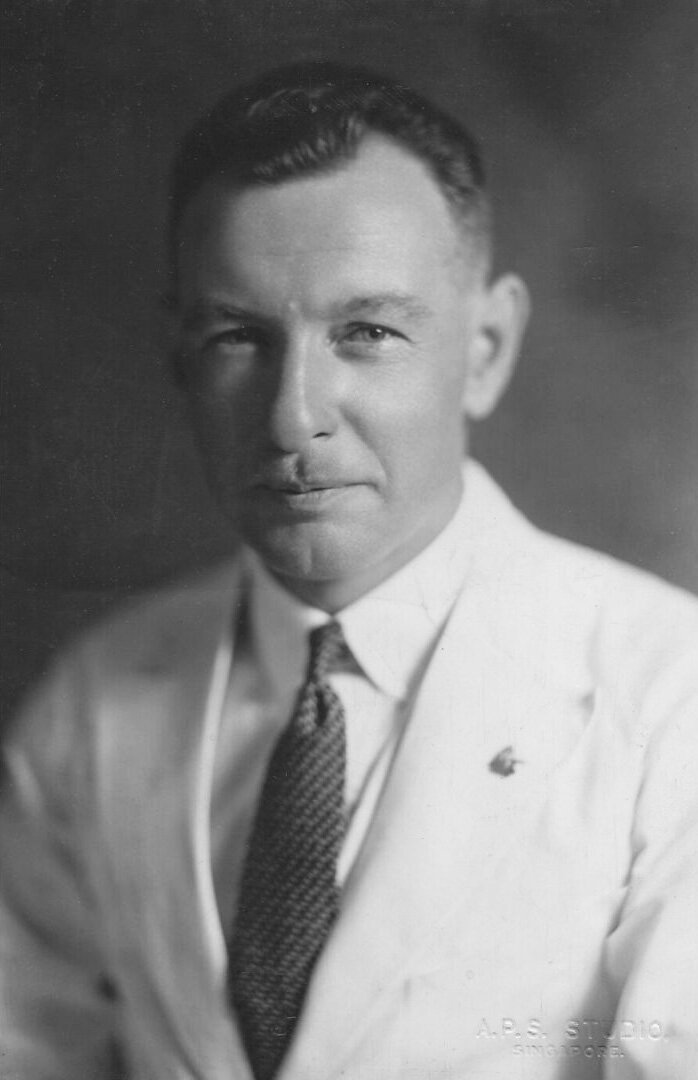James Milner Fraser
Source: The Boys’ Brigade in Singapore
James Milner Fraser (1905-1978) was an architect who was significant in the planning and development of Singapore’s early public housing estates under the Singapore Improvement Trust (SIT). He joined as an Assistant Architect when the Trust was first conceived in 1927 and became Manager after the Second World War until the end of 1956. Acting as Chairman of the Trust until his retirement in July 1958, Fraser also worked in conjunction with the government to prepare the framework and legislation for the Housing and Development Board.
Fraser was born in Aberdeenshire, Scotland, to James Milner Fraser¹, an ironmonger, and his wife Elizabeth Ann Davidson. He received his early education at Kittybrewster Preparatory School and Aberdeen Grammar School. On leaving school, he was apprenticed to James Cobban from June 1920 where he gained experience in estate work, surveying and land subdivision, bungalows, and farm steadings. When Cobban ceased practice in September 1923, Fraser transferred to the office of George Watt, where he completed his apprenticeship in June 1925. Under Watt, he was exposed to a variety of work ranging from hotels, schools, shops, and cinemas to land surveying and levelling.
Throughout his five years of apprenticeship Fraser attended evening classes at the Aberdeen School of Architecture, where Alexander Gordon² was among his tutors. In his final year, Fraser sat for and passed the Intermediate Examination of the Royal Institute of British Architects. He then moved to London where he joined the London County Council (LCC) Housing Department as a Junior Assistant and studied at the Regent Street Polytechnic and at the Northern Polytechnic, Holloway Road. In 1926 he took a position as assistant architect in the West Ham Borough Council where he obtained experience in municipal issues such as housing schemes and tenements. That same year he made an architectural study tour of Rome, Florence, and Paris.
Fraser explains a model of Kampung Silat estate to Sir Franklin Gimson, the Governor of Singapore and G. G. Thomson, the Public Relations Secretary at the 1951 ‘Homes of Singapore’ exhibition. Source: Singapore Improvement Trust Annual Report 1951.
Fraser moved to Singapore and joined the SIT the following year, working in the Municipal Offices under his former tutor Alexander Gordon. He was admitted Associate of the Royal Institute of British Architects (ARIBA) upon passing the final exam in Singapore in August 1928. By the mid-1940s Fraser had been promoted to Manager of the SIT where he, in the subsequent years, supervised the development of houses, shops, and flats. Fraser also published a number of reports and papers on town planning and housing issues. The SIT Annual Reports – beautifully illustrated with photographs, infographics, and building and floor plans – were compiled by Fraser in his capacity as Manager. Proposed by Koh Cheng Yam, Kenneth Alfred Brundle,³ and William Irving Watson, Fraser was admitted Fellow of the RIBA in 1955, by which time he had been awarded a CBE. Fraser left the SIT in 1959 when it was disbanded in order to form the Housing and Development Board (HDB). Fraser joined the Housing Authority in Hong Kong as head and contributed to the development of public housing there.⁴
Besides architecture, Fraser was responsible for founding The Boys’ Brigade movement together with ex-members of the Swatow Company (many fled to Southeast Asia to escape the communist regime). Having been a member since he was eleven years old, The Boys’ Brigade played a large role in Fraser’s formative years. The first Singapore Company was founded at Prinsep Street Presbyterian Church on 12 January 1930.
¹ J M Fraser’s father, and later his son, was also named James Milner Fraser.
² Gordon (1893-1931) moved to Singapore to join the Municipal Architect’s Department in 1923 and was promoted to Chief Municipal Architect in 1925. He died in 1931 while on his way home on leave.
³ C. Y. Koh (1912-1974), as he was better known, was the first Singaporean architectural assistant to join Swan & Maclaren in 1938. Koh graduated from Architectural Association, London in 1933, worked in an architectural firm in London for five years. He was an Associate of the Royal Institute of British Architects by the time he returned to Singapore in 1938. Made senior partner after the Second World War, Koh was instrumental in the revitalisation of Swan & Maclaren into the 1950s.Brundle was an assistant architect in the Malayan Public Works Service from 1938-41. He evacuated Singapore at the outbreak of the Second World War, returning as Chief Architect of the Public Works Department from 1952-1957.
⁴ Miles Glendinning, Mass Housing: Modern Architecture and State Power-a Global History (London: Bloomsbury Visual Arts, 2021), 503–5.
Last modified on 15 August 2021. Written by Jason Ng and edited by Chang Jiat Hwee.
References
Brundle, Kenneth A. ‘Escape from Singapore 1942 (RCMS 103/15/18)’, University of Cambridge Digital Library, accessed 14 May 2021, https://cudl.lib.cam.ac.uk/view/MS-RCMS-00103-00015-00018/1
Davison, Julian. Swan & Maclaren: A Story of Singapore Architecture (Singapore: The National Archives of Singapore, 2020).
Fraser, James Milner, ed. The Work of the Singapore Improvement Trust, 1927-1947 (Singapore: Singapore Improvement Trust, 1948).
Glendinning, Miles. Mass Housing: Modern Architecture and State Power-a Global History. London: Bloomsbury Visual Arts, 2021.
‘James Milner Fraser’, Dictionary of Scottish Architects, accessed 07/05/2021, http://www.scottisharchitects.org.uk/architect_full.php?id=205045
‘Malayan Architectural Personalities: James Milner Fraser, A.R.I.B.A, A.M.I. Struct. E., A.M.T.P.I’, The Malayan Architect 7, no. 10 (1935), 228-29.
Speechley, Soon-Tzu. ‘The Classical Language of Architecture in British Malaya, 1867-1941’, unpublished Ph.D. thesis, University of Melbourne, 2021.
‘The Boys' Brigade in Singapore's Heritage Timeline’, The Boys’ Brigade in Singapore, accessed 14/05/2021, https://timeline.bb.org.sg/Glendinning, Miles. Mass Housing: Modern Architecture and State Power-a Global History. London: Bloomsbury Visual Arts, 2021.Glendinning, Miles. Mass Housing: Modern Architecture and State Power-a Global History. London: Bloomsbury Visual Arts, 2021.



